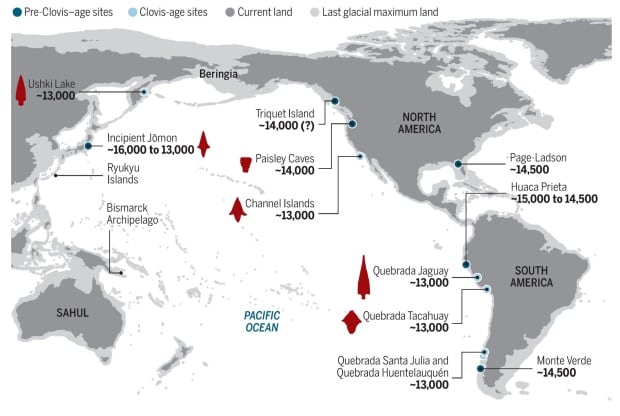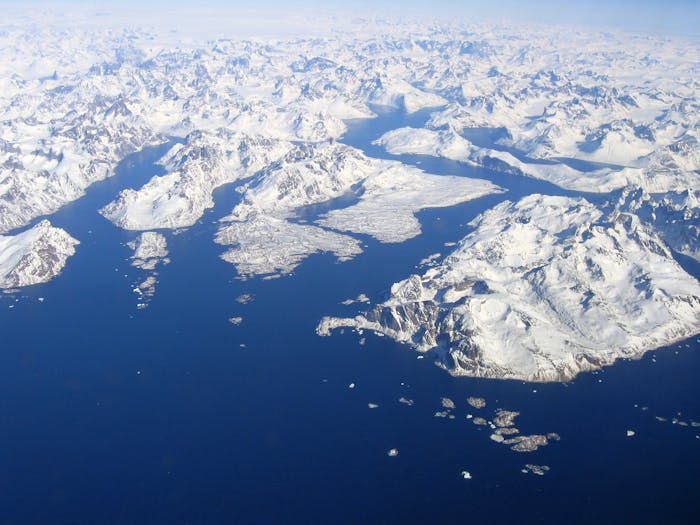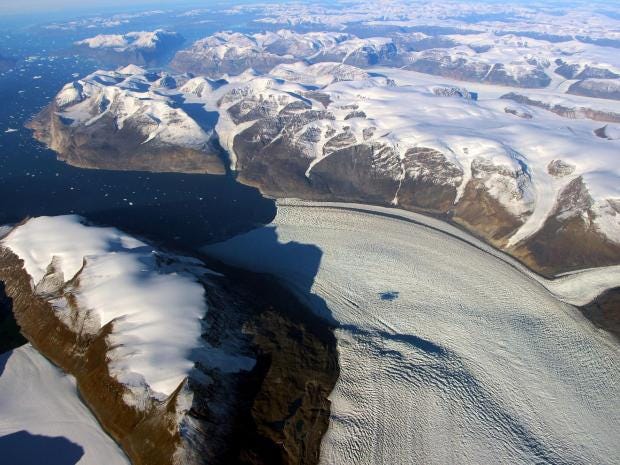Study adds to evidence that first Americans didn't pass through B.C. interior
By Emily Chung, CBC News Posted: Nov 09, 2017 2:00 PM ET Last Updated: Nov 09, 2017 2:00 PM ET
 This 2009 photo released by Extreme Ice Survey shows Birthday Canyon in Greenland during
This 2009 photo released by Extreme Ice Survey shows Birthday Canyon in Greenland during
the filming of Chasing Ice.' New findings about the melting of a western Canadian ice sheet at
the end of the ice age may offer a preview of what's in store for Greenland's ice sheet as it melts
from human-caused climate change. (James Balog/Extreme Ice Survey/Associated Press)
Emily Chung covers science and technology for CBC News. She has previously worked as a
digital journalist for CBC Ottawa and as an occasional producer at CBC's Quirks & Quarks.
She has a Ph.D. in chemistry.
The ice sheet that covered much of Western Canada at the end of the last ice age melted earlier
and more quickly than scientists thought, a new study suggests. The findings bolster evidence
that the melting of the Cordilleran Ice Sheet could have boosted sea levels by up to three metres.
'If you want to understand future and present day, then it's often good to look at the past.'
- Brian Menounos, UNBC
The new research, which uncovers great detail about how the Cordilleran Ice Sheet melted
and fell to pieces, could also provide a preview of what to expect as Greenland melts due to
human-caused climate change.
And it adds to evidence that the first humans in North America did not travel through central
B.C. as they moved south from the Bering Peninsula around 14,000 years ago.
Brian Menounos, the Canadian researcher who led the study, spent 10 years helicoptering into
remote mountaintops in B.C., the Yukon and the Northwest Territories with his team, then
hammering, chiselling, and sawing rectangular rock "brownies" from huge boulders to take
back to the lab. The boulders were located in moraines – huge piles of rock and debris left
behind by melting glaciers that scientists use to understand past climate change.
"If you want to understand future and present day, then it's often good to look at the past,"
said Menounos, a geography professor at the University of Northern British Columbia who
holds a Canada Research Chair in glacier change.
 Brian Menounos and his team hammered, chiselled and sawed 76 rectangular rock 'brownies'
Brian Menounos and his team hammered, chiselled and sawed 76 rectangular rock 'brownies'
(with M&Ms and Lego stormtrooper for scale) from huge boulders on mountaintops to take
back to the lab for analysis. (Brian Menounos/UNBC)
Understanding how the Cordilleran ice sheet melted is particularly useful because it's very
similar to the present-day ice sheet that's melting in Greenland. Both contain similar amounts
of ice, have similar mountainous topography underneath, and feed meltwater directly into the
ocean, Menounos and his colleagues note in a new paper published today in the journal Science.
That means the Cordilleran ice sheet melt could show us what impacts we can expect in the
future as the Greenland ice sheet warms and liquefies.
Traditionally, scientists have used carbon-14 dating to estimate the ages of moraines in
lower-lying areas. That kind of dating suggested that the Cordilleran ice sheet still covered
much of Western Canada around 12,500 years ago.
Carbon dating can't be used in high alpine areas, because the carbon comes from plant and
animal material, and there isn't much of that on remote mountaintops.
So Menounos and his team used a different chemical clock — beryllium-10, which is found in
quartz. Like carbon-14, it's radioactive and is formed when cosmic rays from deep space
interact with atoms on Earth — nitrogen in the atmosphere in the case of carbon-14, and
oxygen in rocks in the case of beryllium-10. Because a layer of ice protects surfaces from
cosmic rays, the amount of beryllium 10 in rocks shows when surfaces were ice-free and exposed
 Researchers collected rock samples from moraine boulders, extracted quartz from them and
Researchers collected rock samples from moraine boulders, extracted quartz from them and
determined the amount of rare isotopes in them. That shows how long the rocks have been
exposed to the surface since their protective ice covering melted. (Brian Menounos/UNBC)
Beryliium-10 dating of 76 boulder brownies from 26 sites showed that high alpine areas in
Western Canada were ice free as early as 14,000 years ago — 1,500 earlier than carbon-14
dating showed.
That's consistent with recent modelling calculations that suggested the Cordilleran ice sheet
melted very quickly over 500 years starting around 14,500 years ago, coinciding with a period
when sea surface temperatures suddenly warmed about 4 C over a few thousand years
(comparable to today's warming of 1 C over around 100 years so far and climbing), causing
massive sea level rise.
Those calculations suggest the Cordilleran ice sheet may have boosted sea levels by 2.5 to three
metres. (While that sounds like a lot, it would have been only a small proportion of the huge
rise in sea levels — up to 14 metres — at that time from melting ice around the world.)
Why did the carbon dates suggest the melt happened so much later? Menounos thinks it's
because the organic matter from plants and animals that carbon-14 relies on may not have
colonized the ice-free landscape until hundreds or even thousands of years after the ice melted.
 Researchers take samples from a low-elevation moraine in the Northwest Territories. A new
Researchers take samples from a low-elevation moraine in the Northwest Territories. A new
study found that remains of the Cordilleran ice sheet have remained at low elevations as late
as 11,000 years ago, but had almost completely melted from higher elevations 14,000 years ago.
(Chris Darvill/UNBC and University of Manchester)
In addition to figuring out when the ice melted, the new study also uncovered other details of
how it melted.
By looking at moraines at different elevations, Menounos and his colleagues found that while
the alpine ice melted quickly, large chunks of ice may have remained in valleys and other lower
lying areas until 11,000 years ago, as the climate fluctuated between warmer and cooler over
several thousand years.
That ice would have been a barrier for any humans who might be trying to pass through
central B.C. until that time, the researchers suggest.
"It would be difficult to find a path," Menounos told CBC News.
That adds to growing evidence that the first people in the Americas may not have travelled
inland between melting ice sheets as previously believed — instead, they likely moved south
from along the Pacific Coast.
 A map shows the locations where evidence of the first people in the Americas have been found.
A map shows the locations where evidence of the first people in the Americas have been found.
There is growing evidence that they travelled along the coast, not inland between melting ice
sheets as previously believed. ( Reprinted with permission from Braje et al., Science 358:592)
The study involved researchers from across Canada along with some from the U.S., Sweden,
Norway and Switzerland.
It was funded by the Natural Sciences and Engineering Research Council fo Canada, the
Canadian Research Chairs Program, the National Oceanic and Atmsopheric Administration,
the National Science Foundation, the Swedish Research Council, Carl Mannerfelts Fond,
A. och M. Bergströms Stiftelse, and the Swedish Society for Anthropology and Geography.

the filming of Chasing Ice.' New findings about the melting of a western Canadian ice sheet at
the end of the ice age may offer a preview of what's in store for Greenland's ice sheet as it melts
from human-caused climate change. (James Balog/Extreme Ice Survey/Associated Press)
digital journalist for CBC Ottawa and as an occasional producer at CBC's Quirks & Quarks.
She has a Ph.D. in chemistry.
The ice sheet that covered much of Western Canada at the end of the last ice age melted earlier
and more quickly than scientists thought, a new study suggests. The findings bolster evidence
that the melting of the Cordilleran Ice Sheet could have boosted sea levels by up to three metres.
- Brian Menounos, UNBC
and fell to pieces, could also provide a preview of what to expect as Greenland melts due to
human-caused climate change.
B.C. as they moved south from the Bering Peninsula around 14,000 years ago.
remote mountaintops in B.C., the Yukon and the Northwest Territories with his team, then
hammering, chiselling, and sawing rectangular rock "brownies" from huge boulders to take
back to the lab. The boulders were located in moraines – huge piles of rock and debris left
behind by melting glaciers that scientists use to understand past climate change.
said Menounos, a geography professor at the University of Northern British Columbia who
holds a Canada Research Chair in glacier change.

(with M&Ms and Lego stormtrooper for scale) from huge boulders on mountaintops to take
back to the lab for analysis. (Brian Menounos/UNBC)
similar to the present-day ice sheet that's melting in Greenland. Both contain similar amounts
of ice, have similar mountainous topography underneath, and feed meltwater directly into the
ocean, Menounos and his colleagues note in a new paper published today in the journal Science.
future as the Greenland ice sheet warms and liquefies.
lower-lying areas. That kind of dating suggested that the Cordilleran ice sheet still covered
much of Western Canada around 12,500 years ago.
animal material, and there isn't much of that on remote mountaintops.
quartz. Like carbon-14, it's radioactive and is formed when cosmic rays from deep space
interact with atoms on Earth — nitrogen in the atmosphere in the case of carbon-14, and
oxygen in rocks in the case of beryllium-10. Because a layer of ice protects surfaces from
cosmic rays, the amount of beryllium 10 in rocks shows when surfaces were ice-free and exposed

determined the amount of rare isotopes in them. That shows how long the rocks have been
exposed to the surface since their protective ice covering melted. (Brian Menounos/UNBC)
Western Canada were ice free as early as 14,000 years ago — 1,500 earlier than carbon-14
dating showed.
melted very quickly over 500 years starting around 14,500 years ago, coinciding with a period
when sea surface temperatures suddenly warmed about 4 C over a few thousand years
(comparable to today's warming of 1 C over around 100 years so far and climbing), causing
massive sea level rise.
metres. (While that sounds like a lot, it would have been only a small proportion of the huge
rise in sea levels — up to 14 metres — at that time from melting ice around the world.)
because the organic matter from plants and animals that carbon-14 relies on may not have
colonized the ice-free landscape until hundreds or even thousands of years after the ice melted.

study found that remains of the Cordilleran ice sheet have remained at low elevations as late
as 11,000 years ago, but had almost completely melted from higher elevations 14,000 years ago.
(Chris Darvill/UNBC and University of Manchester)
how it melted.
the alpine ice melted quickly, large chunks of ice may have remained in valleys and other lower
lying areas until 11,000 years ago, as the climate fluctuated between warmer and cooler over
several thousand years.
central B.C. until that time, the researchers suggest.
inland between melting ice sheets as previously believed — instead, they likely moved south
from along the Pacific Coast.

There is growing evidence that they travelled along the coast, not inland between melting ice
sheets as previously believed. ( Reprinted with permission from Braje et al., Science 358:592)
Norway and Switzerland.
Canadian Research Chairs Program, the National Oceanic and Atmsopheric Administration,
the National Science Foundation, the Swedish Research Council, Carl Mannerfelts Fond,
A. och M. Bergströms Stiftelse, and the Swedish Society for Anthropology and Geography.
 Greenland's coasts are lined with glaciers, some of which extend into the warmer waters deep in the ocean.
Greenland's coasts are lined with glaciers, some of which extend into the warmer waters deep in the ocean. On the left, dark blue regions show land that extends 4,900 feet below sea level. On the right, the darkest red regions show the parts of the land that are connected to the ocean, and the white line shows how far the ice sheet extends.
On the left, dark blue regions show land that extends 4,900 feet below sea level. On the right, the darkest red regions show the parts of the land that are connected to the ocean, and the white line shows how far the ice sheet extends.

/https://public-media.smithsonianmag.com/filer/5c/df/5cdf9cef-0c1f-48f0-b4dc-245e04a78dc6/whole_specimen_by_lida_xing_copy.jpg) Tree resin trapped this baby bird 99 million years ago. (Lida Xing)
Tree resin trapped this baby bird 99 million years ago. (Lida Xing) This reconstruction shows the fierce little bird in action. (Cheung Chung Tat)
This reconstruction shows the fierce little bird in action. (Cheung Chung Tat)

 A meltwater lake can be seen on the Rink Glacier in western Greenland Nasa/OIB
A meltwater lake can be seen on the Rink Glacier in western Greenland Nasa/OIB